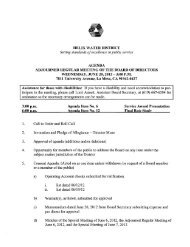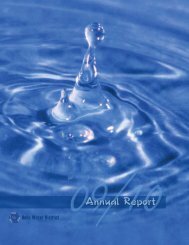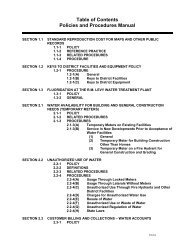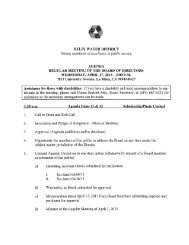HOW TO READ YOUR METER - Helix Water District
HOW TO READ YOUR METER - Helix Water District
HOW TO READ YOUR METER - Helix Water District
- No tags were found...
Create successful ePaper yourself
Turn your PDF publications into a flip-book with our unique Google optimized e-Paper software.
<strong>HOW</strong> <strong>TO</strong> <strong>READ</strong> <strong>YOUR</strong> <strong>METER</strong>Leak DetectorThis may be shaped like a triangle or astar. As water passes through, it willspin. The dial will spin fast for high waterflow and very slowly for small amountsof water movement. If water is notbeing used in the home or on theproperty and this detector is moving, itmay indicate a leak and should beinvestigated promptly. Go towww.hwd.com/metervideo.asf to see ashort video demonstration.Sweep Hand1 revolution = 7.48 gallons = 1 cubic foot100 revolutions = 748 gals = 100 cubic feet = 1 unitMeter RegisterThe meter continually registers any water that passes through it, similar toa car odometer. This particular meter has registered a running total of48,698 cubic feet (or 486.98 units) since it was installed. When a technicianreads the meter, he/she only records the numbers with the whitebackground. The current read of this meter would be recorded as 486. Thecurrent meter read is then subtracted from the previous read taken twomonths prior to calculate the consumption for billing purposes. Forexample, if the previous read was 471, then this customer’s bill wouldreflect a total consumption of 15 units for a two month billing period (486‐471 = 15). To calculate this consumption in gallons, simply multiply by 748:15 units x 748 = 11,220 gallons (1 unit = 748 gallons).<strong>HOW</strong> <strong>TO</strong> TEST FOR LEAKSYour water meter is a great tool to use to monitor your water usage by regularly reading the meter. Doing this can alsohelp you detect silent leaks. By using the current read stated on your bill, you can determine your ongoing water usageat any time during each two month billing period. Simply record what the meter is currently reading, then subtract thatread from the “current read” noted on your most recent bill. This will provide your consumption in units (to convert togallons, multiply by 748). To calculate a daily average consumption, divide the consumption by the number of days sincethe last read date noted on your bill.To check for leaks:
Obtain a current read of your meter. Record all digits (black and white) and note the position of the sweephand.Wait at least four hours (overnight if possible) without using any water. Be sure to turn off any automatic icemakers before starting the test. Don’t flush any toilets, run any faucets, dishwasher, washer, irrigation, etc.during the test period.Check the meter read again. If the numbers have changed, you could have a leak. Check for running toilets orleaky faucets. If there are no signs of an obvious leak, you may need to contact a plumber.<strong>HOW</strong> <strong>TO</strong> LOCATE AND IDENTIFY <strong>YOUR</strong> WATER <strong>METER</strong>Your water meter is typically located in the ground in front of your property near the sidewalk or street in a concretebox. If you need assistance in finding the location of your meter, please call customer service at (619)466‐0585 between8:30 AM and 5:00 PM, Monday through Friday. The meter box lid is a white cement lid labeled “WATER <strong>METER</strong>”.The lid can be easily propped open and removed by using a tool such as a screw driver. Use caution and don’t besurprised to see dirt and debris, spiders, cobwebs, cockroaches and sometimes bees, rodents, lizards, and snakes. Theseare all common things that collect or hide inside the meter box. Some housing and business developments have clustersof meters grouped together known as “nests”. In order to identify your particular meter, reference the meter numberlocated on your bill or call customer service to obtain your meter number. The meter number is labeled on the lid of themeter itself that sits within the meter box.Inside the meter box, you will find the curb‐stop, the meter, and the consumer valve. The curb‐stop is located on<strong>Helix</strong>’s side of the meter and maintained by <strong>Helix</strong>. The consumer valve can be used by the customer to turn their wateroff and on as needed, such as when working with the private plumbing. Anything beyond the meter is considered
private plumbing and is the resposibility of the customer to maintain. However, if there are problems with theconsumer valve, please call our office at (619) 466‐0585 during regular business hours.Consumer ValveMeter Number<strong>Water</strong> MeterCurb‐Stop<strong>HOW</strong> <strong>TO</strong> TURN OFF <strong>YOUR</strong> WATERThe consumer valve can be used by both the customer and <strong>Helix</strong> to control water availability to the property. In the“on” position, the valve sits parallel to the water pipe. In the event that water needs to be turned off to the home (forexample: an emergency pipe break and/or to perform repairs) the consumer valve can easily be turned 90 degreesclockwise (or quarter turn) to the “off” position (perpendicular to the water pipe).Consumer valve turnedclockwise a quarter turn to the“off” position and the valve isperpendicular to water pipe.




